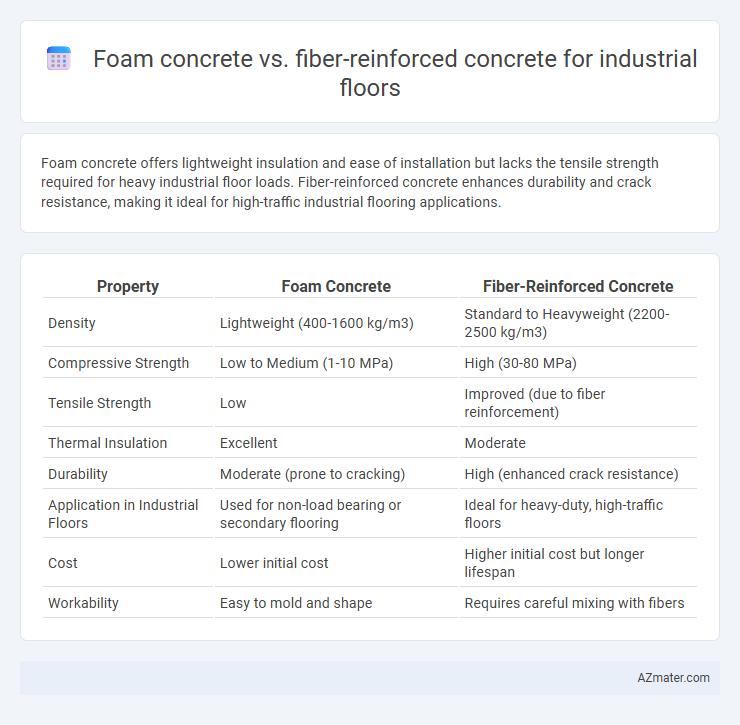Foam concrete offers lightweight insulation and ease of installation but lacks the tensile strength required for heavy industrial floor loads. Fiber-reinforced concrete enhances durability and crack resistance, making it ideal for high-traffic industrial flooring applications.
Table of Comparison
| Property | Foam Concrete | Fiber-Reinforced Concrete |
|---|---|---|
| Density | Lightweight (400-1600 kg/m3) | Standard to Heavyweight (2200-2500 kg/m3) |
| Compressive Strength | Low to Medium (1-10 MPa) | High (30-80 MPa) |
| Tensile Strength | Low | Improved (due to fiber reinforcement) |
| Thermal Insulation | Excellent | Moderate |
| Durability | Moderate (prone to cracking) | High (enhanced crack resistance) |
| Application in Industrial Floors | Used for non-load bearing or secondary flooring | Ideal for heavy-duty, high-traffic floors |
| Cost | Lower initial cost | Higher initial cost but longer lifespan |
| Workability | Easy to mold and shape | Requires careful mixing with fibers |
Introduction to Industrial Flooring Materials
Foam concrete offers lightweight, high thermal insulation, and excellent workability, making it suitable for non-structural industrial flooring applications where load-bearing is minimal. Fiber-reinforced concrete incorporates synthetic or steel fibers to enhance tensile strength, crack resistance, and durability, ideal for heavy-duty industrial floors subjected to intense mechanical stresses. Selecting the appropriate material depends on load requirements, durability needs, and cost-effectiveness for specific industrial flooring projects.
Overview of Foam Concrete
Foam concrete is a lightweight, cellular material consisting of cement slurry mixed with stable foam to create air bubbles, resulting in excellent thermal insulation and low density. Its high flowability and self-leveling properties make it suitable for industrial floor applications where ease of placement and reduced dead load are critical. Compared to fiber-reinforced concrete, foam concrete offers enhanced insulation and reduced weight but generally has lower tensile strength and durability.
Overview of Fiber-Reinforced Concrete
Fiber-reinforced concrete (FRC) enhances industrial floors with superior tensile strength, crack resistance, and durability compared to traditional materials. Incorporating synthetic or steel fibers improves load-bearing capacity and reduces maintenance costs in high-traffic industrial environments. FRC's optimized structural integrity makes it ideal for heavy machinery and forklift use, outperforming foam concrete in resilience and longevity.
Key Material Properties Comparison
Foam concrete offers lightweight properties with densities typically ranging from 400 to 1600 kg/m3, providing excellent thermal insulation and sound absorption but lower compressive strength, generally between 1 to 10 MPa, compared to fiber-reinforced concrete. Fiber-reinforced concrete enhances tensile strength, crack resistance, and durability by incorporating steel, glass, or synthetic fibers, achieving compressive strengths from 30 to over 80 MPa, making it more suitable for high-load industrial floors. While foam concrete excels in thermal insulation and ease of installation, fiber-reinforced concrete is preferred for superior mechanical performance and long-term structural integrity in demanding industrial environments.
Strength and Durability Performance
Fiber-reinforced concrete exhibits superior strength and durability for industrial floors due to the integration of synthetic or steel fibers that enhance tensile resistance and crack control. Foam concrete, characterized by its lightweight and thermal insulation properties, typically offers lower compressive strength and is less suitable for high-load industrial applications. The choice between foam and fiber-reinforced concrete hinges on load-bearing requirements, with fiber-reinforced concrete preferred for heavy-duty durability and structural performance.
Installation and Workability Differences
Foam concrete offers lightweight properties and excellent flowability, enabling easy pouring and leveling on industrial floors, which accelerates installation time. Fiber-reinforced concrete, containing synthetic or steel fibers, improves tensile strength and crack resistance but requires more careful mixing to evenly distribute fibers and maintain workability. While foam concrete excels in rapid placement with reduced labor, fiber-reinforced concrete demands skilled handling to ensure optimal fiber dispersion and durability in heavy-duty floor applications.
Cost Implications and Budget Considerations
Foam concrete offers significant cost savings for industrial floors due to its lightweight nature and lower material costs, reducing transportation and labor expenses. Fiber-reinforced concrete, while more expensive initially, provides enhanced durability and crack resistance, often lowering long-term maintenance and repair costs. Budget considerations should balance the initial investment in fiber reinforcement against foam concrete's affordability and potential for quicker installation.
Resistance to Industrial Loads and Wear
Foam concrete offers lightweight and excellent thermal insulation but falls short in resistance to heavy industrial loads and abrasive wear, making it less suitable for high-traffic industrial floors. Fiber-reinforced concrete incorporates synthetic or steel fibers that significantly enhance tensile strength, crack resistance, and durability under intense mechanical stress, providing superior performance against heavy machinery and repeated loading. For industrial floors subjected to heavy loads and abrasive wear, fiber-reinforced concrete delivers greater longevity and structural integrity compared to foam concrete.
Maintenance and Longevity Factors
Foam concrete offers lightweight properties and excellent thermal insulation but tends to have lower compressive strength and durability, which can increase maintenance frequency for industrial floors exposed to heavy loads. Fiber-reinforced concrete enhances tensile strength, crack resistance, and impact durability, significantly reducing repair needs and extending the lifespan of industrial flooring under high-stress industrial conditions. Choosing fiber-reinforced concrete ensures superior longevity and lower maintenance costs, making it ideal for demanding industrial environments.
Choosing the Best Concrete Type for Industrial Floors
Foam concrete offers lightweight insulation and excellent thermal properties but lacks the high tensile strength essential for heavy industrial floor loads. Fiber-reinforced concrete enhances durability, impact resistance, and crack control, making it more suitable for industrial floors subjected to heavy machinery and dynamic stresses. Selecting fiber-reinforced concrete ensures long-term structural integrity and reduced maintenance costs in industrial settings.

Infographic: Foam concrete vs Fiber-reinforced concrete for Industrial floor
 azmater.com
azmater.com